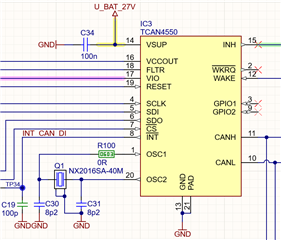Other Parts Discussed in Thread: TCAN4550
Hi,
I have a question about the oscillator setup for the TCAN4550. I used the suggested crystal (NX2016SA-40M) which is shown in the application example in the datasheet, with parallel 8.2pF capacitors at the crystal pins.
Is this a valid design where the TCAN works properly within it's whole temperature range (-40°C - 125°C)??

regards
Tobias

